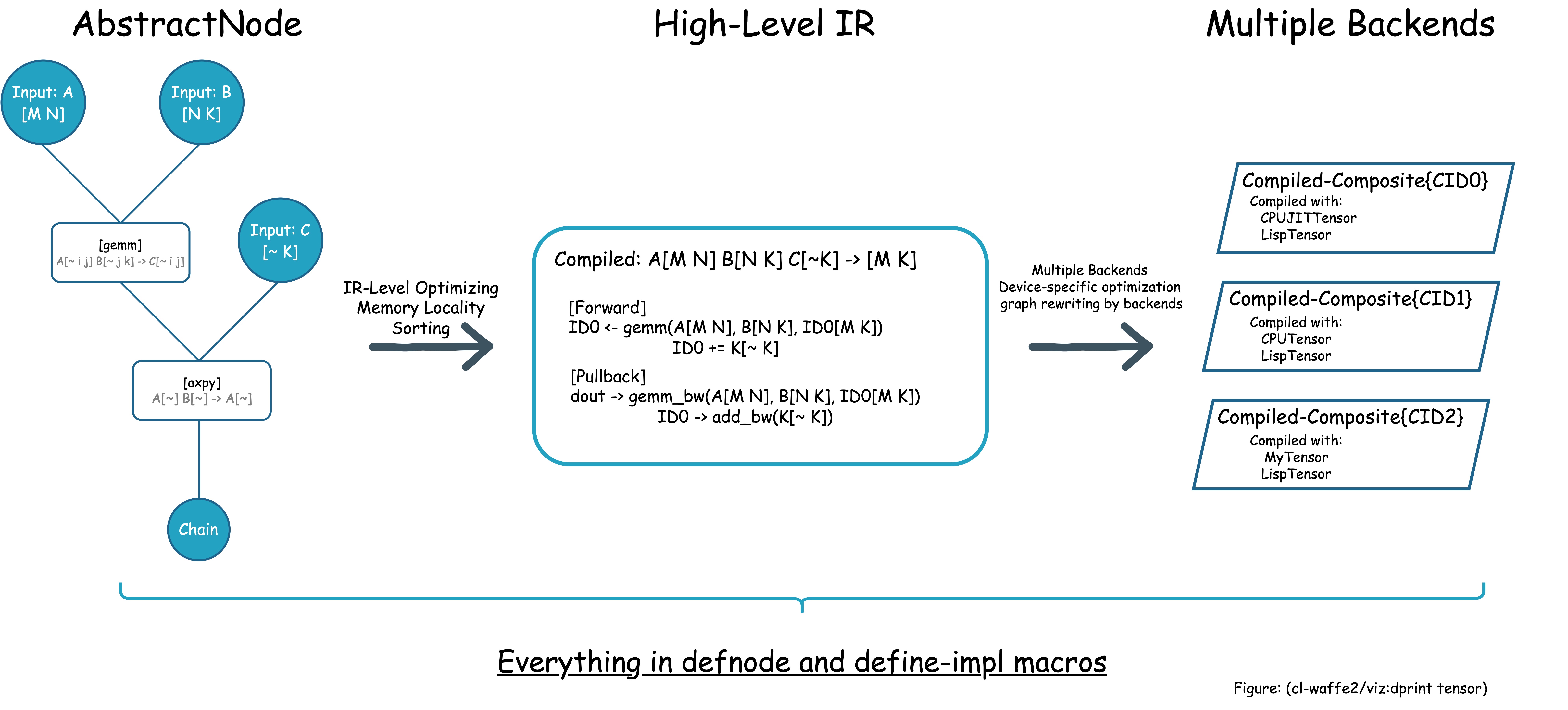Visit the docs »
Concepts
·
Install
·
Examples
⚠️ cl-waffe2 is still in the experimental stage. Things are subject to change, and APIs can be changed without warnings. DO NOT USE CL-WAFFE2 IN YOUR PRODUCT.I actually have a repository cl-waffe(DEPRECATED UNSUPPORTED!) with a similar name. Note that cl-waffe2 is the latest one and all features are inherited from the old one.
cl-waffe2 provides fast, systematic, easy to optimize, customizable, device independent abstract matrix operations, and reverse mode tape-based Automatic Differentiation on Common Lisp. Plus, we also provide features for building and training neural network models, accelerated by a JIT Compiler.
Roughly speaking, this is a framework for the graph and tensor abstraction without overheads. All features provided here can be extended by users without exceptions - and with minimal code. In fact, cl-waffe2 is designed as the truly easiest framework to write extensions by users. There is no barrier between users and developers. There is no restriction imposed by the framework ignoring the developing language is limited to Common Lisp.
As of this writing, its abstraction layers are almost reaching the goals and working enough, but there is still a serious lack of backend functionality, and documentation. Contributions are welcome and I would appreciate if somebody who is interested in by project contact me: hikettei.
- Abstraction cl-waffe2 brings AbstractTensor (and AbstractNode!) to Common Lisp.
- Extensible All operations can be reimplemented with any matrix operation libraries you like! Plus, AbstractNode guarantees that no code rewriting is needed when changing devices.
- Inlining Anyone can write an optimized loop calling foreign libraries; an order is collapsed and shuffled depending on the ranks and offsets.
- Graph-Level Optimization cl-waffe2 provides a powerful abstract graph optimization tool that can be used on any devices. For example, it optimizes the locality of memory, and make operations in-place as much as possible.
- Visualize Super easy to know the bottleneck in your network, because a
proceed-benchfunction profiles every instruction. - Debugging cl-waffe2 is enough clever by not only detecting all Shaping-Error before the execution but it also suggests alternatives! In addition, all objects in cl-waffe2 are nicely rendered on your REPL.
- Systematic Nodes AbstractNodes and Models are based on small and elegant macros.
- Symbolic Differentiation In the first place, cl-waffe2 does not create nodes that are later modified. Compiler macros eliminate functions producing such nodes.
As the simplest example, the build function traces and compiles the network from the endpoints of the computation nodes.
Example1. Compiling nodes
(let ((a (make-input `(A B) :A))
(b (make-input `(A B) :B)))
(let ((model (build (!sum (!mul a b)) :inputs `(:A :B))))
(print model)
;; model is a compiled function: f(a b)
(forward model (randn `(3 3)) (randn `(3 3)))))
;;<Compiled-Composite(allocated-p=NIL)
;; forward : forward(model A B) -> CPUTENSOR{FLOAT}(1 1)
;; backward : backward(model) -> t
;; memory-pool : two tensor(s)
;; L {8.0e-6+((A B) x 4.0e-6)}MB
;; inputs:
;; A -> (A B)
;; B -> (A B)
;;>
;;{CPUTENSOR[float] :shape (1 1) -> :view (<(BROADCAST 1)> <(BROADCAST 1)>) -> :visible-shape (1 1) :named ChainTMP646587
;; ((1.0858848))
;; :facet :input
;; :requires-grad NIL
;; :backward NIL} The advantages of using Common Lisp are numerous:
- The shape of tensors is not limited to numbers, but can also include symbols and even S-expressions!
- Automatic Generation of Iterators, ShapeError, etc.
- Works as a Domain Specific Language for Deep Learning embedded in Common Lisp
Example2. MLP Model
;; From https://github.com/hikettei/cl-waffe2/blob/master/examples/mnist/mlp.lisp
(defsequence MLP (in-features hidden-dim out-features
&key (activation #'!relu))
"Three Layers MLP Model"
(LinearLayer in-features hidden-dim)
(asnode activation)
(LinearLayer hidden-dim hidden-dim)
(asnode activation)
(LinearLayer hidden-dim out-features))
(defun build-mlp-model (in-class out-class &key (hidden-size 256) (activation #'!relu) (lr 1e-3))
(let* ((mlp (MLP in-class hidden-size out-class :activation activation))
(lazy-loss (criterion #'softmax-cross-entropy
(call mlp
(make-input `(batch-size ,in-class) :X))
(make-input `(batch-size ,out-class) :Y)
:reductions (list #'!sum #'->scal)))
(model (build lazy-loss :inputs `(:X :Y))))
(mapc (hooker x (Adam x :lr lr)) (model-parameters model))
(values model mlp)))
(defun step-train-mlp (model x y)
(let ((act-loss (forward model x y)))
(backward model)
(mapc #'call-optimizer! (model-parameters model))
(/ (tensor-vec act-loss) 100)))
(defmethod accuracy ((model MLP) x y)
(let* ((out (!argmax (call model x)))
(label (!argmax y))
(total (proceed (->scal (!sum (A=B out label))))))
(float (/ (tensor-vec total) (nth 0 (shape out))))))Example3. reshape and transform
(!reshape (make-input `(N C H W) nil) (~ N C H W -> (* N C H) W))
(%transform (ax+b `(3) 1 0)[i] -> [~ i])We also provide example projects here!
Don't underestimate the power of lazy evaluation. Nodes are first converted to fully optimized IRs before doing forward and backward propagations.
Since cl-waffe2 is still under development, there are still many optimization techniques remains to be implemented. Even these benchmarks were measured under single-core but shows enough performance!
optimizers=Adam, hidden_size=256
| n_epoch | cl-waffe2 | Keras | PyTorch | JAX |
|---|---|---|---|---|
| 1 | 3.111s | 3.662s | 3.418 | 4.039s |
| 10 | 32.437s | 31.352s | 28.403s | 30.801s |
| 100 | 304.864s | 274.854s | 338.031s | 275.875s |
optimizers=Adam hidden=512
| n_epoch | cl-waffe2 | Keras | PyTorch | JAX |
|---|---|---|---|---|
| 1 | 6.075s | 7.55s | 7.29s | 6.90s |
| 10 | 61.703s | 56.283s | 51.140s | 65.682s |
(Coming Soon...)
(Coming Soon...)
-
All comments on this Reddit post: Does anyone have any interest in my deep-learning framework?.
-
digikar99 for giving me intriguing perspectives on some semantics and the publication of a large number of valuable references.
-
Some of the algorithms implemented within the source code are referenced below:
-
Marsaglia, G., & Tsang, W. W. (2000). The ziggurat method for generating random variables. Journal of statistical software.
-
Previous works of JIT Compiler for Deep Learning:
-
See also my reading list: #47

